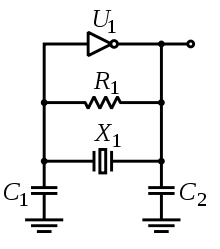Pierce oscillator
The Pierce oscillator is a type of electronic oscillator particularly well-suited for use in piezoelectric crystal oscillator circuits. Named for its inventor, George W. Pierce (1872–1956),[1][2] the Pierce oscillator is a derivative of the Colpitts oscillator. Virtually all digital IC clock oscillators are of Pierce type, as the circuit can be implemented using a minimum of components: a single digital inverter, one resistor, two capacitors, and the quartz crystal, which acts as a highly selective filter element. The low manufacturing cost of this circuit and the outstanding frequency stability of the quartz crystal give it an advantage over other designs in many consumer electronics applications.

Operation
Biasing resistor
R1 acts as a feedback resistor, biasing the inverter in its linear region of operation and effectively causing it to function as a high-gain inverting amplifier. To better understand this, assume the inverter is ideal, with infinite input impedance and zero output impedance. The resistor forces the input and output voltages to be equal. Hence the inverter will neither be fully on, nor fully off, but will operate in the transition region, where it has gain.
Resonator
Extremely low-cost applications sometimes use a piezoelectric PZT crystal ceramic resonator rather than a piezoelectric quartz crystal resonator.
The crystal in combination with C1 and C2 forms a pi network band-pass filter, which provides a 180° phase shift and a voltage gain from the output to input at approximately the resonant frequency of the crystal. To understand the operation, note that at the frequency of oscillation, the crystal appears inductive. Thus, the crystal can be considered a large, high-Q inductor. The combination of the 180° phase shift (i.e. inverting gain) from the pi network, and the negative gain from the inverter, results in a positive loop gain (positive feedback), making the bias point set by R1 unstable and leading to oscillation.
Isolation resistor
In addition to the biasing resistor R1, Ruan Lourens strongly recommends a series resistor Rs between the output of the inverter and the crystal. The series resistor Rs reduces the chance of overtone oscillation and can improve start-up time.[3] This second resistor Rs isolates the inverter from the crystal network. This would also add additional phase shift to C1.[4] Pierce oscillators above 4 MHz should use a small capacitor rather than a resistor for Rs.[4]
Load capacitance
The total capacitance seen from the crystal looking into the rest of the circuit is called the "load capacitance". When a manufacturer makes a "parallel" crystal, a technician uses a Pierce oscillator with a particular fixed load capacitance (often 18 or 20 pF) while trimming the crystal to oscillate at exactly the frequency written on its package.
To assure operation at the correct frequency, one must make sure the capacitances in the circuit match this value specified on the crystal's data sheet. Load capacitance CL can be calculated from the series combination of C1 and C2, taking into account Ci and Co, the input and output capacitance of the inverter, and Cs, the stray capacitances from the oscillator, PCB layout, and crystal case (typically 3–9 pF):[5][6][7][8]
When a manufacturer makes a "series" crystal, a technician uses a different tuning procedure. When a "series" crystal is used in a Pierce oscillator, the Pierce oscillator (as always) drives the crystal at nearly its parallel resonance frequency. But that frequency is a few kilohertz higher than the series resonant frequency printed on the package of a "series" crystal. Increasing the "load capacitance" slightly decreases the frequency generated by a Pierce oscillator, but never enough to reduce it all the way down to the series resonant frequency.
References
- Pierce, George W. (October 1923), "Piezoelectric crystal resonators and crystal oscillators applied to the precision calibration of wavemeters", Proceedings of the American Academy of Arts and Sciences, 59 (4): 81–106, doi:10.2307/20026061, hdl:2027/inu.30000089308260
- US 2133642, Pierce, George W., "Electrical System", issued 18 October 1938
- Lourens, Ruan, Practical PICmicro Oscillator Analysis and Design (PDF), Microchip, p. Figure 13: The position of Rs., AN943
- HCMOS Crystal Oscillators (PDF), Fairchild Semiconductor Corporation, May 1983, pp. 1–2, Fairchild Semiconductor Application Note 340, archived from the original (PDF) on 2013-05-02, retrieved 2007-05-30
- "Quartz crystal glossary of terms" (PDF). Abracon Corporation. Retrieved 2007-06-06.
- "CX miniature crystals" (PDF). Euroquartz. Archived from the original (PDF) on 2007-04-15. Retrieved 2007-06-06.
- Fox Electronics Technical Information
- "Pierce-gate oscillator crystal load calculation" (PDF). Crystek Crystals Corp. Retrieved 2008-08-26.
Further reading
- Matthys, Robert J. (1992). Crystal Oscillator Circuits (revised ed.). Malabar, Florida: Krieger Publishing. ISBN 0-89464-552-8.
External links
- Crystal Theory (PDF), Technical Notes, Somerset UK: EuroQuartz, n.d., retrieved 8 February 2015
